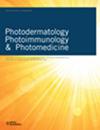A case of pediatric indolent systemic mastocytosis: The role of UVB-NB phototherapy in the treatment of cutaneous lesions.
IF 2.5
4区 医学
Q2 DERMATOLOGY
Photodermatology, photoimmunology & photomedicine
Pub Date : 2023-09-01
Epub Date: 2023-06-16
DOI:10.1111/phpp.12894
引用次数: 0
Abstract
Dear editor, Mastocytosis encompasses a heterogeneous group of disorders characterized by pathological expansion and accumulation of clonal mast cells within one or more organs.1 According to the latest classification, three subtypes of the disease have been recognized based on the site and extent of organ involvement and dysfunction: cutaneous mastocytosis (CM), systemic mastocytosis (SM), and mast cell sarcoma (MCS).2,3 SM has been differentiated into nonadvanced and advanced forms, while the CM is divided into maculopapular CM (MPCM), diffuse CM (DCM), and mastocytoma subtypes.2,3 In pediatric age, mastocytosis is often limited to the skin (CM) and is considered to be a myeloproliferative clonal disease with benign course, outcome, and tendency to spontaneous resolution before puberty.4 Extracutaneous involvement in pediatric mastocytosis is relatively rare, most often presenting in the form of indolent systemic mastocytosis (ISM). Virtually all children with SM present with skin lesions, usually MPCM, accompanied by increased serum tryptase levels.4 Currently, the treatment of SM in pediatric patients lacks of standard guidelines: its primary aim is to limit the release of mediators of mast cell degranulation, by avoiding potential triggering factors. The mainstay of systemic therapy is secondgeneration H1 and H2 antihistamines, useful in decreasing flushing, pruritus, and controlling wheal formation.1,5 A valuable secondline therapy, proposed as an alternative approach for the treatment of refractory cases, is phototherapy.6 UVBNB phototherapy has been shown to be effective in many dermatological pediatric diseases associated with intense itch,7,8 and UVB light has been proven to have an inhibitory effect on mast cell degranulation, likely by causing noncytotoxic damage to the membrane phospholipid metabolism.9,10 Omalizumab has been successfully used to treat severe symptoms related to mastocytosis that are recalcitrant to conventional therapies,11 including cases of CM and ISM in pediatric patients,12 while in case of aggressive SM the clinician can consider the use of imatinib (if mast cells lack the cKIT D816V mutation) or other newer tyrosinekinase inhibitors.13 We report a case of a 13yearold girl, affected by ISM, who presented with cutaneous lesions since the sixth month of life, successfully treated with UVBNB phototherapy. The patient initially received a diagnosis of MPCM, and was referred to our Dermatologic Institute due to progressive worsening of her skin lesions during adolescence. At that time, she presented with several papules and erythematous, brown macules distributed on her face, arms, and trunk, and positivity for Darier's sign. Pruritus was one of the greatest causes of discomfort for the patient. The disfiguring appearance of the skin lesions was correlated with body image concerns, deeply affecting her quality of life (Figure 1). A progressive increase in the serum tryptase values was observed (from the baseline value of 24 ng/mL to 41.3 ng/mL. NV ≤11.5 ng/mL), raising the suspicion of a possible multiorgan involvement and evolution to SM. Skin biopsy was repeated, confirming hyperpigmentation of basal layer of epidermis with diffuse mast cell infiltrates with monomorphous mononuclear cells, round to oval nuclei, granular amphophilic cytoplasm, tryptase, and CD117 positive. A bone marrow biopsy showed the presence of >15 MCs with the coexpression of CD2, CD25, and CD117 at flow cytometry analysis. The cKIT D816V mutation, tested with PCR/RFLP assay, was also positive. FDGPET scan did not show pathologic hypercaptation. Lumbar bone mass densitometry displayed a Zscore below the expected range for age (−2.1). A diagnosis of ISM was made. The patient was initially treated with topical corticosteroids and secondgeneration antihistamines. Nevertheless, symptoms and pruritus control remained unsatisfactory. The psychological and social impact of the儿童无痛性系统性肥大细胞增多症一例:UVB-NB光疗在皮肤病变治疗中的作用。
本文章由计算机程序翻译,如有差异,请以英文原文为准。
求助全文
约1分钟内获得全文
求助全文
来源期刊
CiteScore
4.40
自引率
7.70%
发文量
85
审稿时长
6-12 weeks
期刊介绍:
The journal is a forum for new information about the direct and distant effects of electromagnetic radiation (ultraviolet, visible and infrared) mediated through skin. The divisions of the editorial board reflect areas of specific interest: aging, carcinogenesis, immunology, instrumentation and optics, lasers, photodynamic therapy, photosensitivity, pigmentation and therapy. Photodermatology, Photoimmunology & Photomedicine includes original articles, reviews, communications and editorials.
Original articles may include the investigation of experimental or pathological processes in humans or animals in vivo or the investigation of radiation effects in cells or tissues in vitro. Methodology need have no limitation; rather, it should be appropriate to the question addressed.

 求助内容:
求助内容: 应助结果提醒方式:
应助结果提醒方式:


